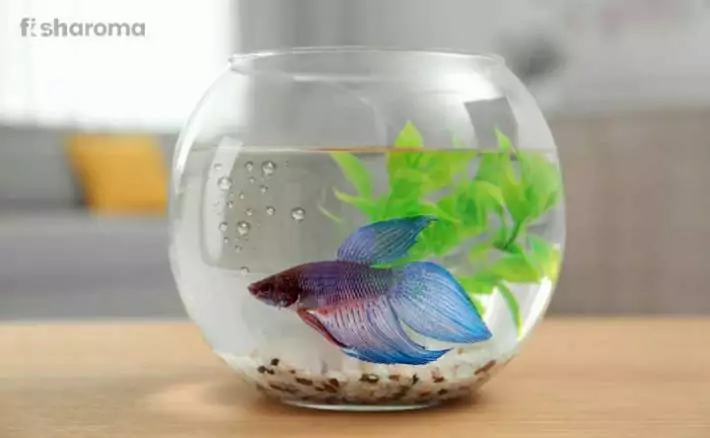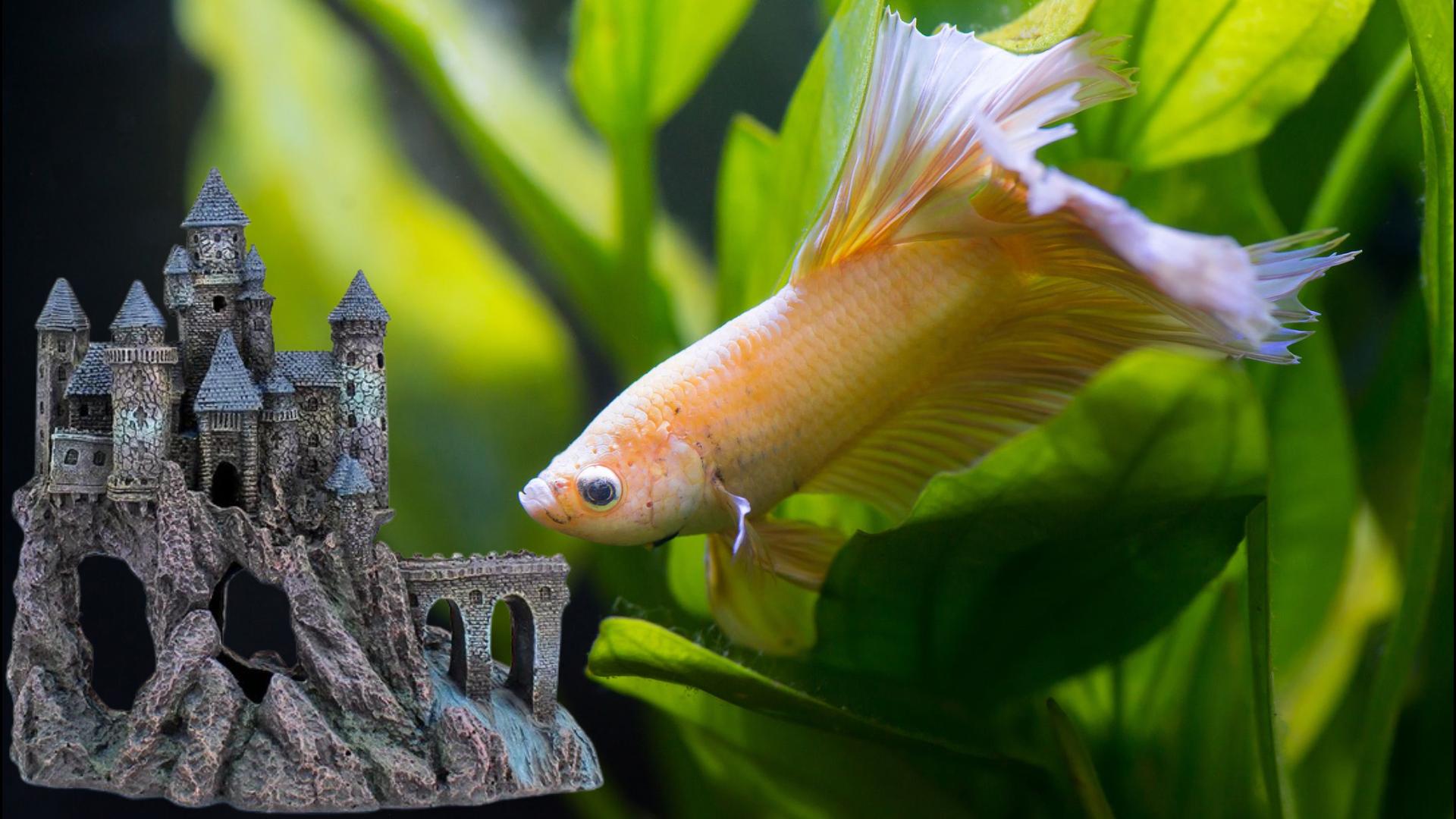Betta fish are easy to identify their gender by looking at them in most cases. But sometimes, they can look similar enough to make it tough to tell the gender of the betta keepers. Let us discuss how to identify the gender of a betta fish based on some easy tips.
The gender of Betta fish can be determined by primary characteristics such as colors, vertical stripes, body shape, fins, egg spots, bread patterns, flaring postures, aggression, and bubble nests. The most common characteristics of male betta fish include longer fins, visible beards, brighter colors, higher aggression, and blow bubble nests. In contrast, female bettas will be lighter in color, have vertical stripes, shorter fins, a less aggressive nature, and appear to have a visible egg spot. Let us look at these characteristics in detail to identify the gender of your betta fish.
Colors – Identify Betta Fish Gender
In general, bright, bold coloration in the body and fins is a clear indication of a male Betta. Males are more vividly colored than females; however, color alone is not a reliable indicator of gender. Sometimes females can also be quite colorful. You can find colorful female betta fish from top-grade breeders. You should also keep in mind that colors can change depending on how stressed the fish is. If your betta fish is new to the tank or stressed, it may mislead you about its gender.

Vertical Stripes
Female bettas will display vertical stripes on their body when they are ready to mate. Females have vertical stripes on their bodies that are considered a reliable indicator of a girl. They make females look more beautiful and glamorous. They do display these lines when they are ready to mate with a male betta.
Body Shape
Betta fish have subtle differences in body shape between males and females. Males tend to be longer and thinner than females. On the other hand, females tend to be shorter and thicker. Male Betta fish will generally have long dorsal-ventral and caudal fins. Betta fish’s dorsal and caudal fins often droop due to their length. It is typical for female Betta fish to have shorter fins. However, the Plakat Betta Fish variety has short fins, so don’t assume that your Betta is a female because of its shorter fins. Female Betta fish ventral fins often resemble hair combs. If you are not sure about the types of betta fins, this picture will explain the fins of betta fish.

Betta Fins
The fins of male bettas are much longer, sometimes as much as four times the length of the fins of females. There are some varieties of betta fish that have males with short caudal fins. However, in most varieties, the females have short caudal fins and the males have long ones. Male ventral fins are much larger and thicker than those of females.
Egg Spot

Betta fishes have a small white spot at the base of their tails, which is known as an ovipositor tube. This spot will resemble a grain of salt. It is located near the edge of the ventral fin near the head of the Betta. A male betta may get a false egg spot, so egg spots aren’t the most accurate way to tell the gender. Be aware that finding this spot may be tough for younger females whose organs aren’t fully developed. As the fish gets bigger and older, the ovipositor tube will be bigger and easier to see. You might want to consider feeding your fish or preparing to feed them if you can’t find the spot. So your betta will move to the top and angle to allow you to see the egg spot more easily.
Beard & Flaring
Betta has a membrane underneath the gill plate cover that is known as the opercular membrane. The membrane appears as a “beard” and is displayed when the fish flares its gill plates. Males often have a beard that is so large that it is visible even when the male is not flaring. A female also has a beard, but it is much smaller and not visible when she isn’t flaring.
There are more obvious differences between the males and females when Bettas flare up. A male’s beard tends to be large, while a female’s beard is smaller and less pronounced. While flaring, females may also assume a head-down posture, which is not observed in males.
Aggression
Betta males are aggressive towards each other and toward females, and they are even violent enough to shorten their lives. There should never be more than one male Betta in a tank. You shouldn’t put male and female Bettas in the same aquarium, except for breeding preparation. Betta female fishes can be aggressive toward each other and other fish, but they are not nearly as aggressive as males. Aggression between females can be extremely stressful, especially if there are only two females in your tank and one of them bullies the other. As a result, if you have more than one, keep at least five females in the same aquarium with the proper tank size recommended so that aggressive behavior is more diffused and not directed at the same person.
Bubble Nests
It is common for males to create bubbles on the surface of the water when they are ready to mate. They produce hundreds or thousands of small bubbles that clump together. Male bettas are usually the ones who produce bubble nests. It’s a nest of saliva bubbles that the fish make on the surface of the water to protect their eggs. This isn’t an absolute rule, because sometimes a female will blow a bubble nest. But those are pretty rare. The males create bubble nests in preparation for breeding with a female and they make nests even if they don’t have a mate yet.
Difference between Plakat Male Betta and Female Betta?
The Plakat betta variety is a short-finned betta breed, so these fish will have short fins which can be easily confused with female betta fishes. Betta lovers often get confused in this situation. However, characteristics discussed in this blog, such as aggression, egg spots, and color, can be helpful when identifying them.
Which Betta Gender Is Right for You? – Identify Betta Fish
The male betta is an excellent choice if you want a minimalist and small aquarium setup. If you want to house him in a smaller tank, add some aquatic plants for cover. The female betta adds color to an existing aquarium. It is possible to add a few so you can view their behavior. Their outward behavior will make it enjoyable for everyone to watch.
How Long can betta fish live in a bowl?
Often, Pet keepers often keep Betta fish in small containers or fish bowls. One of the most common questions among Betta lovers is, Are they able to live naturally in a fish bowl? Is it possible to keep a betta fish healthy in small containers?
In their natural habitats or well-maintained aquariums, Betta fish can live for three to five years. Their life expectancy will drastically decrease if you keep them in a fishbowl. Betta fish live as long as they’re cared for and are kept in the right conditions, just like humans and animals. Let’s take a deeper look at the real benefits and problems of raising betta fishes in small containers.

There are lots of pet store owners, marine life experts, and vets who don’t recommend keeping betta fish in fishbowls. Betta fishes need at least 3 to 5 gallons of tank space, plants, a filter, a heater, and proper water conditions to stay healthy. Because of their natural ability, Betta fish will still be able to live in environments that are difficult to survive. If the water in a tank is not healthy, a fish’s life span will be drastically reduced and they’ll die sooner than their natural lifespan.
People often comment about Betta breeders keeping their fish in small containers. But they recycle 100% of their water at least every 2 days, they feed only fresh food, and maintain proper water quality and temperature, which isn’t possible for pet owners. Additionally, breeders keep Betta fish only from birth to 5 months before selling them.
Every betta keeper should know these few basic tips on betta care to keep your fish happy and healthy. Make sure your fish tank is at least 5 gallons in size. Betta fish enjoy the water with a pH of 6.5 to 7.5 and a temperature of 76 to 81 degrees Fahrenheit. The water in your tank should be treated with a dechlorinating water conditioner whenever you add water to it. Betta fishes do not need filtered tanks, but they will keep the water cleaner, reducing the amount of time you have to spend cleaning your tank. In choosing a betta’s tank, choose at least one or two hideouts, so your fish have somewhere to hide away and relax. These hideouts can be planted or silk hideouts to swim through or rocks. It’s critical to remember that betta fish have delicate fins, so pick smooth decorations and soft plants that won’t catch on their fins and tails. Feed your betta once or twice a day at about the same time. If you feed your betta pellet food, you will need to feed him 5 to 8 pieces based on your betta size. Keep a tank heater setup in case the temperature can drop below 76 degrees Fahrenheit.





